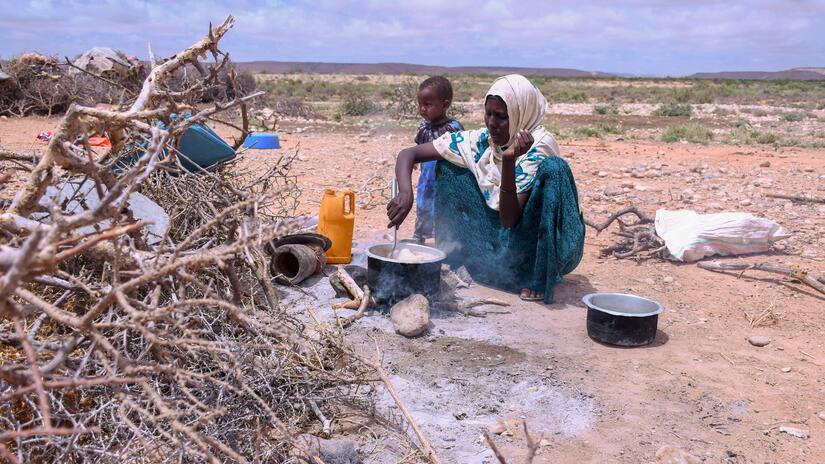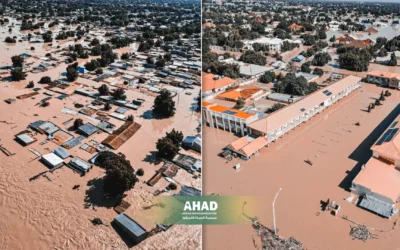Climate and its impact on hunger in Africa
Africa is one of the continents most affected by climate changes, as the climate significantly affects agriculture and food security on the continent. Hunger is one of the biggest challenges facing many African countries, exacerbated by extreme climatic conditions such as droughts, floods and unexpected changes in weather patterns. In this article, we will review the impact of climate on hunger in Africa, the reasons behind it, the devastating effects, and possible solutions to face this crisis.
Climate change and its impact on agriculture
Drought and degradation of agricultural land
Climatic changes have led to a decrease in the rate of precipitation in many African regions. This decrease translates into a lack of water needed to irrigate agricultural land, which hinders crop growth and leads to a decrease in agricultural productivity. Farmers in many African regions rely on rainfall as their main source of water, so any changes in precipitation patterns can have serious consequences for food security.
Constant drought leads to desertification, a process in which fertile agricultural land turns into barren and unsuitable for cultivation. Desertification reduces the Earth’s ability to support plant life and leads to a loss of biodiversity. Dry and decaying soils make it difficult to grow the staple crops on which rural communities depend, increasing food insecurity.
Most of the agriculture in Africa depends on rains. This dependence makes agricultural production vulnerable to climatic fluctuations, as years of drought can lead to complete crop failure. In the absence of sustainable irrigation systems, farmers suffer from the inability to adapt to prolonged droughts, which makes it more difficult to achieve sustainable agricultural production.
Floods and natural disasters
Climatic changes also lead to an increase in the intensity and frequency of floods. Flash floods destroy crops and agricultural infrastructure, causing huge losses to farmers and exacerbating hunger. Floods erode the soil and wash away essential nutrients, making the lands less fertile and difficult for future agriculture.
Floods contribute to erosion, a process in which the fertile surface layer of the soil is removed, which leads to a deterioration in the quality of the soil and its suitability for cultivation. In addition, floods can lead to contamination of groundwater and surface water with chemicals and other pollutants, which affects the quality of water used for irrigation and drinking.

The impact of climate change on agricultural biodiversity
Climate change is affecting traditional crop varieties that farmers in Africa rely on. Rising temperatures and changing precipitation patterns lead to the inability of some crops to grow in their traditional environments. As a result, crop diversity is lost, which increases the dependence of communities on a limited number of plants that are more resistant to climate changes, but this can be risky if these plants encounter any pathological or environmental problems.
Rising temperatures and changes in weather patterns lead to the extinction of some animal and plant species. This extinction negatively affects agricultural ecosystems, as species that play a vital role in pollination, pest control and soil improvement are lost. The loss of these species leads to a disturbance of the ecological and agroecological balance, which increases the difficulty of sustainable agriculture.
Climate change and food security
Climate changes lead to a decrease in crop productivity. Changes in temperature and precipitation patterns affect crop growth cycles and make it difficult for farmers to predict growing seasons. This lack of productivity leads to a shortage of locally available food, which raises prices and makes food unavailable to poor groups.
Countries that are affected by a decrease in domestic agricultural production may have to increase dependence on food imports to meet the needs of their population. This dependence on imports makes countries vulnerable to fluctuations in world markets and increases the risk of hunger in the event of any trade disruptions or fluctuations in world prices.
Food shortages and malnutrition lead to weakened immunity and an increase in diseases, which increases mortality rates especially among children and the elderly. Malnutrition impairs public health, making individuals more vulnerable to infectious and non-communicable diseases, and leads to reduced working capacity and productivity, contributing to the spiral of poverty and hunger.
The reasons behind the impact of climate on hunger in Africa
Environmental and natural factors
Climate changes have disrupted the usual weather patterns in many African regions. These changes make it difficult for farmers to predict the growing seasons and plan their plantings effectively. When rains are irregular or come at an unusual time, agricultural crops are negatively affected. Farmers, especially those who rely on traditional agriculture, find it difficult to cope with these rapid changes, which leads to crop loss and increased hunger.
The constant rise in temperatures is detrimental to agricultural production, since many crops are sensitive to thermal changes. High temperatures lead to increased evaporation of water from the soil and plants, which increases the need for watering. In regions that are already experiencing water shortages, this problem becomes more complicated, which affects the ability of farmers to preserve their crops.
Natural disasters
Flash floods destroy crops and agricultural infrastructure, causing huge losses to farmers and exacerbating hunger. Waterlogged soils lose their fertility, and it becomes difficult to replant them without a long break for their rehabilitation.
Hurricanes and storms lead to the destruction of crops and agricultural property, which increases the suffering of agricultural communities. Infrastructure such as roads, bridges and aqueducts are severely damaged, which hinders the transportation of agricultural products to markets and increases the cost of production.
Economic and social factors
The widespread poverty in many African countries makes it difficult for communities to invest in modern agricultural technologies or prepare for natural disasters. Technologies such as modern irrigation systems, improved seeds, and chemical fertilizers are often beyond the reach of the poor, limiting their ability to improve their agricultural productivity.
The poor are more dependent on rain-dependent agriculture and unsustainable natural resources. In the absence of the necessary support and guidance, these farmers remain vulnerable to climatic fluctuations, which makes them more vulnerable to hunger when climatic conditions change unexpectedly.
The growing population increases the pressure on natural and food resources, exacerbating hunger. The growing demand for food requires an increase in agricultural production, but climate change makes it difficult to achieve this sustainably.
Rapid population growth requires a sustainable increase in agricultural production, which is complicated by climate change. Uneven food production with population growth leads to food shortages and high food prices, making it difficult for the poor to get enough food to meet their basic needs.
Political factors
Armed conflicts and political instability impede humanitarian access and endanger the lives of the population. Conflicts lead to the displacement of the population and the destruction of infrastructure, which makes it difficult for farmers to work their land and produce food.
Armed conflicts often lead to severe food shortages, as crops and agricultural infrastructure are destroyed, exacerbating the hunger crisis. Conflicts also affect markets and trade, making it more difficult to transport and distribute food to those in need.
The lack of government investments in agricultural infrastructure hinders the improvement of agricultural productivity and makes it difficult for farmers to adapt to climate changes. Investments in irrigation systems, crop storage, and transportation are essential to ensure the sustainability of Agriculture and increase production.
The absence of effective agricultural policies and government support negatively affects the ability of farmers to face the challenges of climate change. Policies that promote research and development in the field of sustainable agriculture, and provide financial and technical support to farmers, are essential to address the impacts of climate change on food security.
Climate change adaptation and sustainability strategies
An investment in modern irrigation systems can help farmers cope with rainfall fluctuations and improve their agricultural productivity. Drip irrigation and subsurface irrigation systems are effective in using water sustainably.
Improving crop storage and transportation technologies can reduce post-harvest losses and ensure that food reaches markets more efficiently. The construction of refrigerated warehouses, processing and packaging facilities can help maintain the quality of agricultural products.
Adaptation to climate changes
Diversification of agricultural crops can reduce the risks associated with weather changes and increase the flexibility of agricultural systems. The cultivation of drought-resistant crops with short growth cycles can be part of an adaptation strategy to climate change.
Investing in agricultural research to develop new technologies and methods to meet the challenges of climate change is essential. The development of new varieties of drought-and heat-resistant crops can help improve agricultural productivity.
Enhancing food security:
Educating farmers and training them to use modern technologies and sustainable agricultural practices can increase their ability to adapt to climate changes. Agricultural training programs can include how to use fertilizers effectively, water management, and pest control.
Providing financial and technical support to small farmers can help them improve their productivity and increase their income. The creation of microcredit and grant programs can provide the necessary financing for small investments in sustainable agriculture.
Regional and international cooperation
Strengthening cooperation between African countries in the field of Agriculture and climate change can help in the exchange of knowledge and technologies. The establishment of regional initiatives to support agricultural research and the exchange of experiences can enhance the ability of African countries to meet climate challenges.
International support from international organizations and donor countries can help provide the necessary funding for climate change adaptation projects. Providing financial and technical assistance to sustainable agricultural projects can enhance food security on the African continent.
Climate change is one of the biggest challenges facing agriculture and food security in Africa. Climate change affects agriculture through changes in weather patterns, increased frequency of natural disasters, and degradation of agricultural biodiversity. These effects lead to a lack of food production, increased dependence on imports, worsening poverty and hunger. To overcome these challenges, agricultural infrastructure must be strengthened, sustainable agricultural technologies adopted, political stability achieved, and regional and international cooperation strengthened. Through these efforts, it is possible to strengthen the ability to adapt to climate changes and achieve sustainable food security in Africa.
You can visit the AHAD website to find out more about the projects it offers
ALSO READ
WHAT THE FOOD BASKET CONTAINS IN AHAD
Join us in our message





